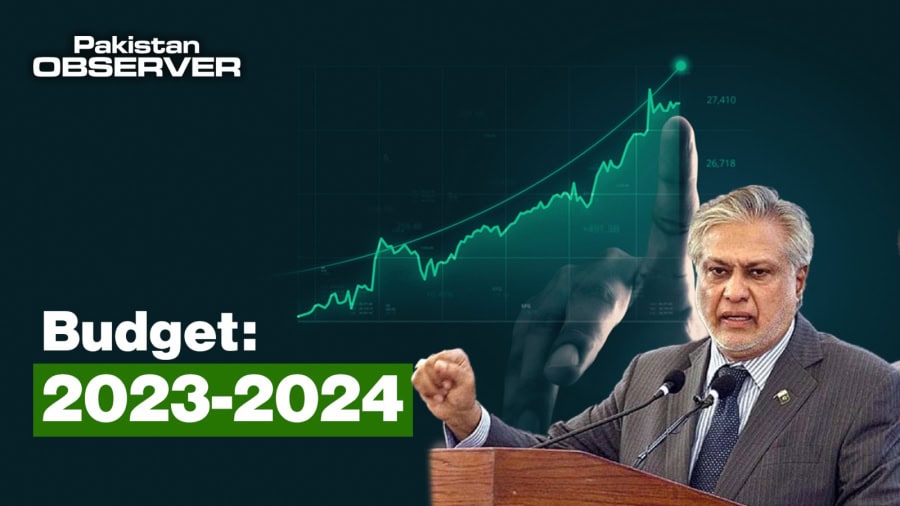For Live speech click below.
🔴 LIVE | Pakistan's BUDGET 2023-2024 | Ishaq Dar Speech #budget2023https://t.co/h2DvHAo21j
— Pakistan Observer (@pakobserver) June 9, 2023
ISLAMABAD – Finance Minister Senator Ishaq Dar on Friday presented Rs 14,460 billion federal budget for the fiscal year 2022-23 with a development outlay of Rs2709b.
Unveiling proposed allocation at the National Assembly after getting formal approval from the federal cabinet, Dar said that it was the best possible budget in the tough economic conditions being faced by the country in the aftermath of global recession and worst floods.
Out of Rs2709b development outlay, Rs950b has been allocated for PSDP and Rs200b for public-private partnership while provinces would carry out development with Rs1559b.
For giving relief to the serving and retired government employees, 35 per cent increase has been proposed in salaries of up to BPS-16 employees and 30 per cent for those of BPS-17 and above. Similarly, 17.5 per cent increase in pension has also been proposed. Minimum wages have been fixed at Rs32000.
Total income has been estimated at Rs12163b. After giving Rs5276 share to the provinces, income of federal government is estimated at Rs6887b. Revenue collection target of Federal Board of Revenue has been set at Rs9200b, direct taxes Rs3759b and indirect taxes Rs5441b, non-tax revenue Rs2963b, federal receivable Rs2531b, provinces surplus Rs650b and privatization Rs15b.
For getting an option for further revenue generation, maximum limit of petroleum development levy has been enhanced from existing Rs50 per litre to Rs60 per litre.
The minister has proposed allocation of Rs7303b for debt servicing and Rs1804b for defense spending. As many as Rs430b has been allocated for Benazir Income Support Program, Rs81.9b for education, Rs22.8b for health, Rs170b for Prime Minister’s Special Initiatives including Rs10b for laptop scheme, Rs491.b for infrastructure development, Rs89b for energy sector, Rs267b for transport and communications, Rs99.8b for water resources, Rs43.6b for physical planning, Rs200b for emergency situations, Rs1074b for subsidy on different items, Rs60.9b for Azad Kashmir, Gilgit-Baltistan and special areas, Rs57b for districts merged in Khyber Pakhtunkhwa and Rs761b for paying pensions
Inflation has been estimated at 21 per cent, GDP growth 3.5 per cent, agriculture production 3.5 per cent, industry 3.4 per cent, manufacturing 4.3 per cent, services 3.6 per cent, forestry and fisheries 3 per cent, education 3 per cent, real estate 3.6 per cent, financial and insurance sector 3.7 per cent.
No tax will be levied on industrial sector for supporting large scale manufacturing. Similarly, duty free import of hybrid and certified seeds, combined harvesters, rice seeders and planters has been allowed. In addition, Rs30b has been allocated for converting agriculture tubewells on solar. Tax has also been reduced from 15 per cent to 5 percent on IT services.
Key Takeaways
- GDP growth target – 3.5 percent
-
IT sector got SME status
-
Export Council of Pakistan formed for export sector
-
No new tax on Industrial Sector
Major Allocations
- Higher education commission – Rs65bn
- HEC’s development expenditure – Rs70bn
- PM Laptop Scheme for students – Rs10bn
- Women empowerment programme – Rs5bn
- PM-Specialised Training Programme for Youth- Rs5bn
- BISP – Rs450bn
- PM’s Youth Loan Programme – Rs10bn
- Benazir Undergraduate Scholarship – Rs6bn
- Utility Stores – Rs35bn
- Bait-ul-Maal for medical treatment of poor Rs4bn









